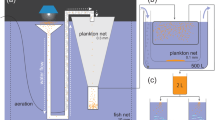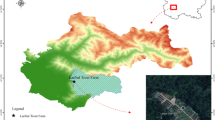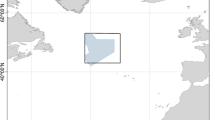Abstract
The aim of the present study was to assess the length–weight relationship and condition factor of ten fish species belonging to Scombridae family. Samples of the each species caught by using multiple types of gear like drift gill net, long line, gill nets and commercial trawls were collected from July 2018 to January 2020. Mainly, drift gill net (mesh size: 120- 140 mm) of 50 m length and 6–8 m breadth by multiday fishing trip lasts for 5 to 6 days and trawlers with a cod-end mesh size of 25–35 mm in single day fishing operated at a depth ranging from 20 and 300 m were used. Among the ten species, five species (i.e. Auxis thazard, Auxis rochei, Acanthocybium solandri, Thunnus albacares and Euthynnus affinis) showed isometric growth. Growth results of four species (i.e. Katsuwonus pelamis, Rastrelliger kanagurta, Scomberomorus commerson and Sarda orientalis) indicate positive allometric growth and one species, Thunnus tonggol showed negative allometric growth. The calculated Fulton’s condition factor value ranged from 1.145 to 1.722 indicating a very healthy condition of the fishes. The results revealed intercept slope ‘b’ value range as 3.271 to 2.2581 with r2 value of 0.959–0.993. The present study has contributed the additional knowledge of fish population of Scombrideae, which could assist fishery management scientists in carrying out future ecological conservative strategies for restoration and management.

Similar content being viewed by others
Data Availability
The data that support the findings of this study are available from the corresponding author upon request.
References
Barnham CPSM, Baxter A (1998) Condition Factor, K, for salmonid fish. Fisheries Note 05:1–3
Blackweel BG, Brown ML, Willis DW (2000) Relative weight (Wr) status and current use in fisheries assessment and management. Rev Fis Sci 8(1):1–44
Collette BB, Nauen CE (1983) FAO Species Catalogue. Vol. 2. Scombrids of the world. An annotated and illustrated catalogue of tunas, mackerels, bonitos and related species known to date. Rome: FAO. FAO Fish Synop 125(2):137
Fakhri A, Fekrandish H, Pazira A, Rastgoo A (2015) Length-weight relationship and growth parameters of kingfish (Scomberomorus commerson) in the north of the Persian Gulf. J Fish Aquat Sci 10(6):592–596. https://doi.org/10.3923/jfas.2015.592.596
FAO (2018) The State of World Fisheries and Aquaculture 2018 – Meeting the Sustainable Development Goals. Rome 224
Fricke R, Eschmeyer WN, Fong JD (2020) Species by Family/Subfamily. Eschmeyer's Catalog of Fishes.http://researcharchive.calacademy.org/research/ichthyology/catalog/ Species By Family.asp.Online Version, Updated 14 September 2020
Froese R, Tsikliras AC, Stergiou KI (2011) Editorial note on weight-length relations of fishes. Acta Ichthyol Piscat 41:261–263. https://doi.org/10.3750/AIP2011.41.4.01
Froese R (2006) Cube Law, Condition Factor and Weight- Length Relationship: History, Meta-Analysis, and Recommendations. J Appl Ichthyol 22:241–253
Jasmine S, Rohit P, Abdussamad EM, Koya S, Joshi KK, Kemparaju S (2013) Biology and fishery of the Bullet tuna, Auxis rochei (Risso, 1810) in Indian waters. Indian J Fish 60(2):13–20
Jatmiko I, Widodo A, Setyadji B, Fahmi Z (2016) Enumeration methods used to investigate the production of yellowfin tuna (Thunnus albacares) in Indian Ocean: Case Study of Tuna Monitoring in Benoa Port, Bali, Indonesia. IOTC-2016-WPM07–17
Le Cren ED (1951) The length-weight relationship and seasonal cycle in gonad weight and condition in the perch (Perca fluviatilis). J Ani Ecol 20:201–219
Mozsar A, Boros G, Saly P, Antal L, Nagy SA (2015) Relationship between Fulton’s condition factor and proximate body composition in three freshwater fish species. J Appl Ichthyol 31:315–320. https://doi.org/10.1111/jai.12658
Noegroho T, Hidayat T, Amri K (2013) Some Biological Aspect of Frigate tuna (Auxis thazard), Bullet tuna (Auxis rochei) and Kawakawa (Euthynnus affinis) in West Coast Sumatera FMA 572, Eastern Indian Ocean, IOTC-2013-WPNT-1,03–19
Richter TJ (2007) Development and evaluation of standard weight equations for bridgelip sucker and largescale sucker. N Am J Fish Manag 2(7):936–939
Roul SK, Kumar RR, Ganga U, Rohit P (2017) Length–weight relationship of Rastrelliger brachysoma (Bleeker, 1851) and Rastrelliger faughni Matsui, 1967 from the Andaman Islands. India J Appl Ichthyol 33(6):1266–1267. https://doi.org/10.1111/jai.13469
Sivadas M, Mohamed Sathakkathullah S, Suresh Kumar K, Kannan K (2016) Assessment of impact of fishing on Indian mackerel Rastrelliger kanagurta (Cuvier, 1816) in Tuticorin, south-east coast of India. Indian J Fish 63(3):33–38. https://doi.org/10.21077/ijf.2016.63.3.58881-04
Uma Mahesh V, Ghosh S, Sreeramulu K, Rao MVH, Satish Kumar M (2018) Fishery, biology and stock structure of the King seer, Scomberomorus commerson off Andhra Pradesh. J Mar Biol Ass India 60(2):18–23. https://doi.org/10.6024/jmbai.2018.60.2.2012-02
Wootton RJ (1990) Ecology of Teleost Fishes. Chapman and Hall, London, pp 117–158
Yosuva M, Jeyapragash D, Manigandan V, Machendiranathan M, Saravanakumar A (2018) Length-weight relationship and relative condition factor of yellowfin tuna (Thunnus albacares) from Parangipettai coast, southeast coast of India. J Zool Ecol 28(2):94–99. https://doi.org/10.1080/21658005.2018.14553
Acknowledgements
The authors are grateful to the University Grants Commission (UGC), New Delhi for providing financial assistance under Dr. D. S. Kothari Postdoctoral Fellowship Scheme (No.F,4-2/2006 (BSR)/BL/17-18/0101) and Department of Fisheries Science, Animal Health and Management, Alagappa University, Karaikudi for lab facilities.
Funding
This work was supported by University Grants Commission (UGC), New Delhi under Dr. D. S. Kothari Postdoctoral Fellowship Scheme (No.F,4–2/2006 (BSR)/BL/17–18/0101) and Alagappa Univeristy RUSA-Phase 2.0 grant sanctioned vide Letter No. F.24–51/2014-U, Policy (TN Multi-Gen), Dept. of Edn, Govt. of India, Dt. 09.10.2018.
Author information
Authors and Affiliations
Corresponding authors
Ethics declarations
Ethical Approval
Compliance with Ethical Standards. This article does not contain any experimental studies with animals performed by any of the authors.
Conflicts of Interest
The authors declare that they have no conflict of interest.
Additional information
Publisher's Note
Springer Nature remains neutral with regard to jurisdictional claims in published maps and institutional affiliations.
Rights and permissions
About this article
Cite this article
Karuppiah, K., Ethiraj, K., Sekar, S. et al. Weight–length Relationships and Fulton’s Condition Factors of Ten Commercially Important Scombridae Fish Species in Southeast Coast of India, Bay of Bengal. Thalassas 38, 709–713 (2022). https://doi.org/10.1007/s41208-021-00390-5
Received:
Revised:
Accepted:
Published:
Issue Date:
DOI: https://doi.org/10.1007/s41208-021-00390-5




